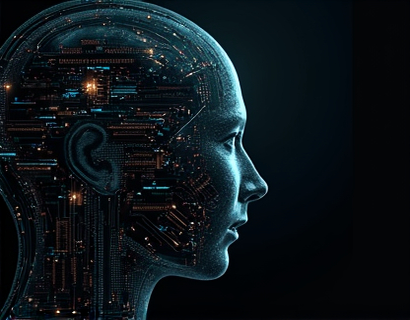Revolutionizing Digital Engagement: The Synergy of Crypto and AI
The intersection of cryptocurrency and artificial intelligence (AI) is ushering in a new era of digital engagement, transforming how users interact with technology and driving unprecedented growth in the tech sector. This article explores the latest innovations at the forefront of this revolution, providing valuable insights for tech enthusiasts and professionals alike. By leveraging the unique capabilities of both crypto and AI, developers and businesses are creating more secure, efficient, and personalized digital experiences.
The integration of blockchain technology with AI algorithms is opening up new possibilities for data management, security, and user interaction. Blockchain's decentralized and transparent nature complements AI's ability to process and analyze vast amounts of data, resulting in enhanced trust and efficiency. This synergy is particularly impactful in the realm of digital engagement, where user experience and data integrity are paramount.
Enhanced Security through Blockchain and AI
One of the most significant benefits of combining crypto and AI is the substantial improvement in security. Blockchain technology provides a robust framework for secure data storage and transaction processing, while AI enhances this security through advanced threat detection and response mechanisms. AI algorithms can analyze patterns and anomalies in real-time, identifying potential security breaches before they occur. This proactive approach ensures that user data remains protected, fostering greater trust in digital platforms.
For instance, AI-powered systems can monitor blockchain networks for suspicious activities, such as unusual transaction patterns or unauthorized access attempts. By integrating machine learning models with blockchain, these systems can adapt and evolve, staying ahead of emerging threats. This dynamic security model is crucial for maintaining user confidence in crypto-based applications and services.
Personalized User Experiences
AI-driven personalization is another key area where crypto and AI intersect to revolutionize digital engagement. By leveraging AI's capabilities in data analysis and machine learning, platforms can offer highly customized experiences tailored to individual user preferences and behaviors. This level of personalization not only enhances user satisfaction but also increases engagement and retention rates.
In the context of crypto, personalized experiences can extend to financial services, such as customized investment portfolios and tailored cryptocurrency trading strategies. AI algorithms can analyze a user's historical data, market trends, and risk tolerance to provide personalized recommendations. This not only improves the user experience but also helps in making more informed financial decisions.
Content Recommendation Systems
Content recommendation systems powered by AI are a prime example of personalized digital experiences. These systems use machine learning to analyze user interactions, such as clicks, shares, and comments, to predict and suggest relevant content. In a crypto context, this can mean recommending articles, tutorials, or even trading strategies based on a user's interests and behavior. Such personalized content not only keeps users engaged but also educates them on the latest developments in the crypto space.
Moreover, AI can help in curating community-driven content, ensuring that users are exposed to a diverse range of perspectives and information. This democratization of content helps in building a more informed and engaged user base, which is essential for the growth of crypto ecosystems.
Decentralized Applications and AI
Decentralized applications (dApps) are at the forefront of the crypto revolution, and AI is playing a pivotal role in enhancing their functionality and user experience. dApps, by design, operate on blockchain networks, offering decentralized and transparent services. AI integration can further augment these applications by providing intelligent automation, predictive analytics, and enhanced user interfaces.
For example, AI can be used to optimize the performance of dApps by dynamically adjusting resource allocation based on user demand and network conditions. This ensures that applications remain responsive and efficient, even during peak usage times. Additionally, AI-driven chatbots and virtual assistants can provide users with real-time support and guidance, reducing the need for human intervention and improving overall user satisfaction.
Smart Contract Optimization
Smart contracts, a cornerstone of blockchain technology, can also benefit from AI integration. AI algorithms can analyze smart contract code to identify potential vulnerabilities and optimize performance. This not only enhances the security of smart contracts but also ensures they operate efficiently, reducing execution times and costs. By automating the optimization process, AI helps developers create more robust and reliable smart contracts, which is crucial for the widespread adoption of decentralized applications.
Furthermore, AI can assist in the automation of contract execution based on predefined conditions and market data. This level of automation not only streamlines processes but also reduces the risk of human error, making dApps more trustworthy and user-friendly.
Data Privacy and User Control
Data privacy is a critical concern in the digital age, and the combination of crypto and AI offers innovative solutions to enhance user control over personal data. Blockchain's decentralized nature ensures that data is not stored in a single, vulnerable location, while AI can help users manage and monetize their data more effectively.
AI-powered tools can enable users to grant or revoke access to their data seamlessly, ensuring that they maintain control over who can use their information. Additionally, blockchain-based identity verification systems, enhanced by AI, can provide secure and privacy-preserving authentication methods. This empowers users to verify their identity without compromising their personal data, fostering a more secure and user-centric digital environment.
Data Marketplaces
Data marketplaces are another area where crypto and AI converge to enhance user experiences. These platforms allow users to buy, sell, and trade data securely and transparently. AI can optimize these marketplaces by matching data suppliers with buyers based on relevance, quality, and price. This not only increases the efficiency of data transactions but also ensures that users receive fair compensation for their data.
Moreover, AI can help in verifying the authenticity and quality of data, reducing the risk of fraud and ensuring that users have access to reliable information. This level of transparency and control is essential for building trust in data-driven ecosystems, which are increasingly becoming a cornerstone of modern digital services.
Future Prospects and Challenges
The integration of crypto and AI holds immense potential for the future of digital engagement, but it also comes with its own set of challenges. One of the primary challenges is the regulatory landscape, as governments and regulatory bodies worldwide are still grappling with how to address the unique aspects of crypto and AI. Navigating these regulations will be crucial for the sustainable growth of crypto-AI applications.
Another challenge is the technical complexity involved in integrating these technologies. Developers need to possess a deep understanding of both crypto and AI to create robust and efficient solutions. However, as the ecosystem matures, more tools and frameworks will become available, making it easier for developers to build innovative applications.
Interdisciplinary Collaboration
To overcome these challenges and fully realize the potential of crypto and AI, interdisciplinary collaboration is essential. Experts from various fields, including blockchain development, machine learning, data science, and legal studies, need to work together to create comprehensive solutions. This collaborative approach will not only drive technological advancements but also ensure that ethical and legal considerations are adequately addressed.
Educational initiatives and community-driven projects can play a significant role in fostering this collaboration. By promoting knowledge sharing and best practices, the community can accelerate the development of cutting-edge crypto-AI solutions that benefit users across the globe.
Conclusion
The convergence of cryptocurrency and artificial intelligence is revolutionizing digital engagement, offering enhanced security, personalized experiences, and decentralized applications. As these technologies continue to evolve, they will drive significant growth and innovation in the tech sector. For tech enthusiasts and professionals, staying informed about the latest advancements in crypto and AI is crucial for harnessing their full potential and contributing to the next generation of digital solutions.










































